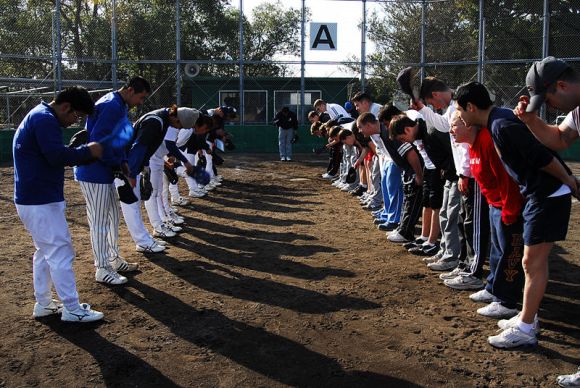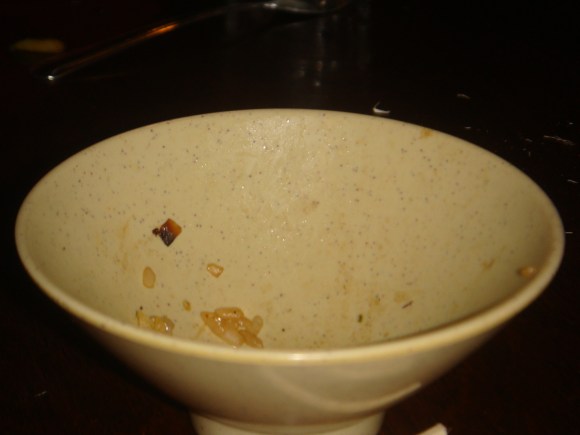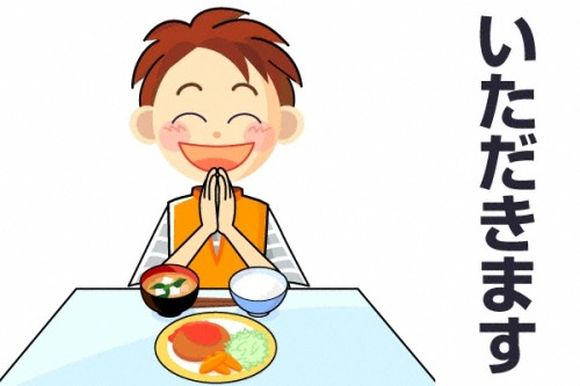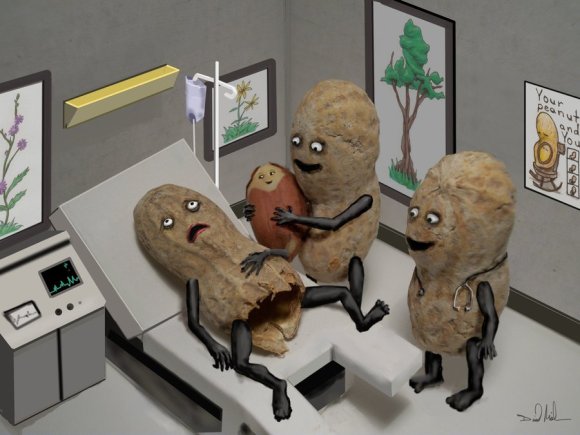
Well, good afternoon/evening/morning/day everyone! Today we’re going to talk about Japanese greetings and what they really mean.
Just as in English, “Konnichiwa” or “Good day” is a greeting that is technically an idiom with a complex and near-forgotten past. Just as English language greetings tend to stem from bastardizations of foreign loan words and/or full sentences that have been gradually shortened over the years, “konnichiwa” is actually a shortened version of a full and meaningful greeting, because, if anything, human beings are a lazy sort with a bad habit of cutting corners whenever possible.
“Konnichiwa,” back in the day, was actually the beginning of a sentence that went, “konnichi wa gokiken ikaga desu ka?,” or “How are you feeling today?” (今日はご機嫌いかがですか?)
Building on that, it’s easy to see that the traditional Japanese greeting in the evening, “Konbanwa“ is basically the same thing, but with “this evening” substituted for “today” (今晩はご機嫌いかがですか?).
When it comes to mornings, we deviate slightly with “ohayou” or “ohayou gozaimasu“ depending on how much you respect the recipient of the greeting (when it comes to my editor, he gets nothing but a curt, “ossu.”), which is spelled in Japanese, “お早う,” or, literally, “It’s early!” Again, humans being the lazy things we are, we can’t be bothered doing anything more than exclaiming about the ungodly hour every morning, so this is understandable.
There’s even more word origin fun to be had with Japanese greetings/idioms:
“Arigatou” or “Thank you” is spelled something like this in Japanese: 有難う, which, taken literally, means, “It’s hard that this exists.” In other words, you’re expressing gratitude for someone doing something difficult or going out of their way for you.
“Gochisousama,” the traditional phrase uttered after a fulfilling meal, and spelled “ご馳走様,” in Japanese literally means, “You ran around!” It sounds weird to an English speaker, of course, but it’s meant to recall a hard-working chef hustling to and fro to prepare a meal.
“Itadakimasu,” the phrase one is supposed to say just before tucking into a meal, on the other hand, is spelled “頂きます,” or literally, “I take!” While it sounds a little blunt and self-serving in English, it’s not hard to understand that this honorific phrase is used to express gratitude to the chef or host.
“Otsukaresama” is a greeting you’ll hear a lot around Japanese offices, schools and any other place where people work hard. The Japanese, “お疲れ様,” literally meaning, “You look tired!” The 様 part, which appears in a lot of these greetings/idioms, is hard to explain in English, but it stems from the Japanese の様 (“no yo,” or, “as if”), which denotes an observation on the part of the speaker.
“Omedetou,” (“Congratulations!”) is a more complicated animal, and even after some research and asking Japanese friends, we still aren’t entirely sure of this word’s origins. But, it appears that it stems from the verb, “mederu” (愛でる), “to treat importantly,” combined with “itashi” (甚し), “very.” In other words, you are acknowledging to someone that their accomplishment is “very important” to you. Note that the current kanji characters used for this, “お目出度い,” are actually what is referred to as “ateji” or kanji characters assigned to fit the sound of the word, rather than the other way around, and have nothing to do with the word’s meaning/origin.
Bonus tip! Being the incredibly handsome/gorgeous bilingual journalists we are, RocketNews24 writers feel for the common Japanese language learner. While Japanese grammar can seem perplexing at first, it’s actually quite intuitive. Take, for example, the verb modifier, “miru,” as in “shite miru,” or, “I will try.” When you look at the origin of this modifier, “して見る,” you see that it literally means, “I will do it, and see.” So, if you were to say something like, “歌ってみる,” at your next office karaoke session, you’re literally saying, “I will sing this song, and see [how it goes].” In our case, it will always go poorly.
If you’re looking for more Japanese language primers, you can check out Rachel, who inspired this article, on YouTube:
Feature photo: Wikimedia Commons, Inset 1, Inset 2, Inset 3




 Sometimes Japanese customer service is so good, it’s hilarious
Sometimes Japanese customer service is so good, it’s hilarious New Hatsune Miku Music Video “ODDS&ENDS” Leaves the World in Tears 【Updated】
New Hatsune Miku Music Video “ODDS&ENDS” Leaves the World in Tears 【Updated】 Let’s learn Japanese through terrible “American jokes”
Let’s learn Japanese through terrible “American jokes” 10 Japanese phrases for travelers that will help, amuse, or just plain confuse
10 Japanese phrases for travelers that will help, amuse, or just plain confuse 10 Japanese expressions that sound delightfully strange and funny when translated
10 Japanese expressions that sound delightfully strange and funny when translated Starbucks Japan ready to get Year of the Horse started with adorable drinkware and plushies【Pics】
Starbucks Japan ready to get Year of the Horse started with adorable drinkware and plushies【Pics】 Beautiful sightseeing boat is a floating tea ceremony venue in east Japan’s best hot spring town
Beautiful sightseeing boat is a floating tea ceremony venue in east Japan’s best hot spring town 7-Eleven Japan’s ramen-cooking robot whipped us up a bowl of noodles【Taste test】
7-Eleven Japan’s ramen-cooking robot whipped us up a bowl of noodles【Taste test】 Japan’s oldest largetooth sawfish in captivity back on display in Mie Prefecture
Japan’s oldest largetooth sawfish in captivity back on display in Mie Prefecture This is possibly the coziest train in all Japan thanks to onboard hot spring footbaths【Pics】
This is possibly the coziest train in all Japan thanks to onboard hot spring footbaths【Pics】 7 great places to see Mt. Fuji from without having to climb it
7 great places to see Mt. Fuji from without having to climb it We try five menu recommendations from a clerk at CoCo Ichibanya and almost fall in love
We try five menu recommendations from a clerk at CoCo Ichibanya and almost fall in love Japanese curry chain in Thailand has a surprisingly Japanese dish not found in Japan
Japanese curry chain in Thailand has a surprisingly Japanese dish not found in Japan New Japanese menstrual product seeks to help women spot unidentified iron deficiencies
New Japanese menstrual product seeks to help women spot unidentified iron deficiencies Design-your-own-Pokémon-T-shirt service launches at Uniqlo, dozens of species to work with【Pics】
Design-your-own-Pokémon-T-shirt service launches at Uniqlo, dozens of species to work with【Pics】 Disillusionment at Tsukiji’s tourist-target prices led us to a great ramen restaurant in Tokyo
Disillusionment at Tsukiji’s tourist-target prices led us to a great ramen restaurant in Tokyo Japan may add Japanese language proficiency, lifestyle classes to permanent foreign resident requirements
Japan may add Japanese language proficiency, lifestyle classes to permanent foreign resident requirements Lacquerware supplier to emperor of Japan and Pokémon team up for new tableware
Lacquerware supplier to emperor of Japan and Pokémon team up for new tableware Starbucks Japan releases new zodiac chilled cup drink for 2026
Starbucks Japan releases new zodiac chilled cup drink for 2026 Cyberpunk anime meets traditional culture in Ghost in the Shell gold leaf Japanese changing screens
Cyberpunk anime meets traditional culture in Ghost in the Shell gold leaf Japanese changing screens Hello Kitty Choco Egg figures are an adorable trip through three periods of Japanese pop culture【Pics】
Hello Kitty Choco Egg figures are an adorable trip through three periods of Japanese pop culture【Pics】 Japan’s otoshidama tradition of giving kids money at New Year’s gets a social welfare upgrade
Japan’s otoshidama tradition of giving kids money at New Year’s gets a social welfare upgrade Japan’s human washing machines will go on sale to general public, demos to be held in Tokyo
Japan’s human washing machines will go on sale to general public, demos to be held in Tokyo 7-Eleven Japan starts new temporary luggage storage service in over 300 branches
7-Eleven Japan starts new temporary luggage storage service in over 300 branches Starbucks teams up with 166-year-old Kyoto doll maker for Year of the Horse decorations【Photos】
Starbucks teams up with 166-year-old Kyoto doll maker for Year of the Horse decorations【Photos】 Tokyo considering law requiring more trash cans following litter increase in heavily touristed area
Tokyo considering law requiring more trash cans following litter increase in heavily touristed area Tokyo’s Tsukiji sushi neighborhood asks tour groups to stay away for the rest of the month
Tokyo’s Tsukiji sushi neighborhood asks tour groups to stay away for the rest of the month Nintendo’s Kirby now delivering orders at Kura Sushi restaurants, but not in Japan
Nintendo’s Kirby now delivering orders at Kura Sushi restaurants, but not in Japan Tokyo event lets you travel back in time, for free, to celebrate 100 years since Showa era start
Tokyo event lets you travel back in time, for free, to celebrate 100 years since Showa era start Sanrio theme park in Japan announces plans to expand into a Sanrio resort
Sanrio theme park in Japan announces plans to expand into a Sanrio resort Stamina-destroying “Paralysis Noodles” are Tokyo’s newest over-the-top ramen innovation
Stamina-destroying “Paralysis Noodles” are Tokyo’s newest over-the-top ramen innovation Survey asks foreign tourists what bothered them in Japan, more than half gave same answer
Survey asks foreign tourists what bothered them in Japan, more than half gave same answer Japan’s deadliest food claims more victims, but why do people keep eating it for New Year’s?
Japan’s deadliest food claims more victims, but why do people keep eating it for New Year’s? We deeply regret going into this tunnel on our walk in the mountains of Japan
We deeply regret going into this tunnel on our walk in the mountains of Japan Studio Ghibli releases Kodama forest spirits from Princess Mononoke to light up your home
Studio Ghibli releases Kodama forest spirits from Princess Mononoke to light up your home Major Japanese hotel chain says reservations via overseas booking sites may not be valid
Major Japanese hotel chain says reservations via overseas booking sites may not be valid Put sesame oil in your coffee? Japanese maker says it’s the best way to start your day【Taste test】
Put sesame oil in your coffee? Japanese maker says it’s the best way to start your day【Taste test】 No more using real katana for tourism activities, Japan’s National Police Agency says
No more using real katana for tourism activities, Japan’s National Police Agency says The top 10 annoying foreign tourist behaviors on trains, as chosen by Japanese people【Survey】
The top 10 annoying foreign tourist behaviors on trains, as chosen by Japanese people【Survey】 Starbucks Japan reveals new sakura drinkware collection, inspired by evening cherry blossoms
Starbucks Japan reveals new sakura drinkware collection, inspired by evening cherry blossoms How to say every Japanese car brand’s name, and what they mean 【Video】
How to say every Japanese car brand’s name, and what they mean 【Video】 Five Japanese sign language phrases with interesting reasoning behind them
Five Japanese sign language phrases with interesting reasoning behind them Japanese idioms become cute anime girls in latest anthropomorphization video game【Video】
Japanese idioms become cute anime girls in latest anthropomorphization video game【Video】 Japanese Twitter shares the funniest “mysterious Japanese” that they’ve heard from foreigners
Japanese Twitter shares the funniest “mysterious Japanese” that they’ve heard from foreigners “Good on the floor?” Five funny times Google Translate drops the ball with Japanese idioms
“Good on the floor?” Five funny times Google Translate drops the ball with Japanese idioms Drink like an ox, eat like a horse! Five Japanese idiomatic phrases to celebrate Year of the Ox
Drink like an ox, eat like a horse! Five Japanese idiomatic phrases to celebrate Year of the Ox What does a kanji with 12 “kuchi” radicals mean? A look at weird, forgotten Japanese characters
What does a kanji with 12 “kuchi” radicals mean? A look at weird, forgotten Japanese characters Hello Kitty learns sign language in newest friendship with Japanese artist
Hello Kitty learns sign language in newest friendship with Japanese artist How do you say “Happy New Era” in Japanese?
How do you say “Happy New Era” in Japanese? When “yes” means “no” — The Japanese language quirk that trips English speakers up
When “yes” means “no” — The Japanese language quirk that trips English speakers up Japanese commercial explaining how to greet a foreigner accused of racism
Japanese commercial explaining how to greet a foreigner accused of racism The top 70 words that keep showing up in Japanese light novel titles (and yes, isekai is one of them)
The top 70 words that keep showing up in Japanese light novel titles (and yes, isekai is one of them) Spice up boring Japanese classroom vocab with the cooler words in this cute video【Video】
Spice up boring Japanese classroom vocab with the cooler words in this cute video【Video】
Leave a Reply